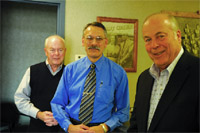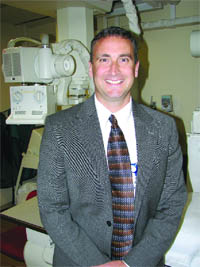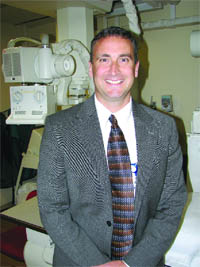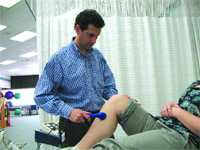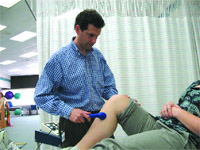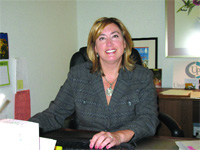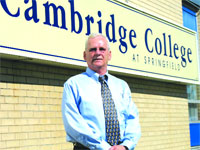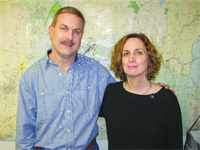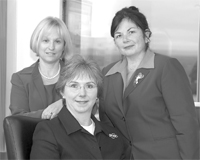Area Colleges Are Applying Imagination to Enrollment- building Efforts
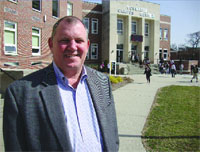
AICs Peter Miller says that colleges need to be more sophisticated than ever to reach enrollment targets.
American International College is targeting young people in China, as well as individuals who simply cant find a seat at a four-year school in California. Meanwhile, UMass Amherst is putting added focus on out-of-state students. These are just some of the strategies being applied as area colleges seek to bolster their enrollment numbers, which have been steadily rising over the past several years.
This is the season that high-school seniors have been waiting for all year. Upcoming graduation? Guess again.
By May 1, all students expecting to go on to college this fall will need to make their decisions regarding where they will go. Its called Candidates Reply Date, and for the admissions departments at area four-year colleges, this time of year is critical.
The word from local colleges is that application numbers are strong for the incoming freshman class of 2010, mirroring a trend in place for the last several years.
It has been widely reported that, during the first months of the recession, students were returning to school in record numbers. But that trend toward higher application numbers, and resulting higher enrollment sizes, are the only constants in the admissions process. In Western Mass., colleges saw their class sizes swell, but in many cases the competition for those students has led to substantive changes in the admissions process.
At American International College, Vice President for Admission Services Peter Miller said that the school is far more sophisticated than ever before in how it does its job. From national and international outreach all the way to use of social media, the role of admissions is more important than ever to secure those target numbers. Some schools go to great lengths in their use of contemporary technology, but Miller only half-jokingly said, if I ever text-message for a prospective student, Ive told my colleagues to shoot me!
The numbers game for student population has changed the admissions techniques, but it also has led some schools to focus on their brand image the goods and services that can be sold to high-school prospects.
In these highly competitive times, improved campus amenities make a big difference, said Mary DeAngelo, interim director of Enrollment Management at Springfield College. We have recently opened two new facilities that help in making the college appealing to prospective students. We have a brand-new campus union that just opened in January. Students are thrilled with it. Last fall, 2008, we opened a new recreation and wellness facility, which is second to none.
UMass Amherst Chancellor Robert Holub has publicly stated his goals for gradual growth of the student body to better represent the schools status as a state flagship university. His goal has a focus on attracting out-of-state students, whose tuition money stays on campus, rather than state students payments, which are filtered into the state revenue stream.
There has been wide support of his initiative, but voices on campus have publicly criticized the cost of attracting such a population, and the means to make it happen. The numbers game of student enrollment has reached a critical stage for colleges attempting to keep up with years of record student populations, but some ask, when is not enough too much?
Digital Readout
DeAngelo said that the school year beginning in fall 2009 has been very interesting.
I think youll hear that from just about any private school, she continued. And it was because of the economy. We were very uncertain how enrollment would turn out, even though application numbers were good, and interest was high. But families were really anxious. When they are sitting at the kitchen table on April 27, they had to ask themselves, can we afford a private college?
Others echoed that sentiment. While the recession caused many families to take a sober look at their expenses for higher education, 2009 was a great year for the states flagship Amherst campus. We set a record last year, and the year before, said Ed Blaguszewski, director of the schools News and Information Office.
We have been at over 30,000 applications for the last three years for incoming freshman, he continued, and we believe that continues to indicate a very strong interest in the value of a UMass education, at an affordable price.
Kathleen Wrobleski, director of Communications and Marketing at Bay Path College, called the economic downturn a double-edged sword. While students and families grapple with the cost of a college education, when times are tough, people historically head back to school.
With finances as a potential pitfall to prospective students, she said that is one area where Bay Path stands out. We recognized early on that people shouldnt have finances as a barrier to going to college. Weve made institutional changes to make that happen. For the undergraduate program, and the Saturday program, there are more scholarships. We have a very aggressive program.
She said that Bay Paths method of admissions is different than most, with undergraduate, one-day, and graduate programs accepted on a rolling basis throughout the year. Every October, however, a snapshot of all three populations is offered for statistical analysis. From that perspective, Wrobleski said that Bay Paths enrollment was at 2,000, the highest in the colleges history.
Tools of the Trade
By the time President Obama made a pledge last year that the U.S. will have the highest proportion of college graduates in the world, the numbers across the nation were already steadily edging toward that goal.
Statistics from the U.S. Department of Education show that, over the past 10 years, the percentage of students who go on to college within 12 months of high-school graduation has increased significantly. In 2007, that number was at 67% of the nations youth. Competition for those best and brightest is at an all-time peak as well, college officials say.
According to Wrobleski, Bay Path has something unique to offer as a means of driving students to their campus. We develop programs that are very career-focused, and very responsive to the job market.
Elaborating, she said, in its graduate program, Bay Path has an MBA in entrepreneurial thinking and innovative practices, the only one of its kind in the area. And then we have an MS in nonprofit management. These are closely linked to many of the job opportunities in this region.
DeAngelo said that her job is essentially the top of a pyramid that extends over the campus, with recruiting new students seen as everyones job.
And that comes from the top down, she continued, which it needs to, in order to be successful. Dr. Richard Flynn has been president for 11 years, and from his first day on this campus, every time he has a chance to speak to all members of the college community at one location, he says that recruiting students is everyones job. What that means is we enjoy great support from the faculty, other administrators, coaches who are a great recruiting force for us from students, and phenomenal support from our alumni base.
At AIC, Miller agreed that recruitment is a campus-wide endeavor. He, too, credits the schools current administration as influential. As our first new president in many, many years, Vincent Maniaci came in with a lot of enthusiasm and vision, and he wanted to move AIC forward.
What that has translated into is expansion of several programs and departments at the school, both locally and far afield. New departments and majors have been coupled with an increase in athletics, and the coaching staff has been given full-time status in order to take more than one for the team.
If we want to get to the number that we want to each year, Miller explained, we know that we need to rely on the football coach to recruit 75 students. We set goals for each coach, but weve added new teams. Theres been enormous success with a new track and field team in attracting students.
As full-time faculty, the coaching staff operates on several levels. In addition to their ability to recruit, they are also often closely linked to the students performance at school. Miller said that this is an enormous aid in student retention from year to year.
Those numbers, from freshman year on through graduation, have been improved, he said, by about 7% between the last years, and by 5% between the years prior.
Go East, Young Man
Miller had just returned from a recruiting trip to China, which he said was the colleges newest focus for out-of-state students.
Parallel to the colleges accreditation process a few years back, something revisited every 10 years, was a period of self-study for the vision of AIC.
We decided that we wanted to be more global in what we were doing, he said. Weve created some pretty significant goals in internationalizing the campus, both for our current students and integrating into the classroom what international students can bring to the campus. China is a country that weve targeted, one obvious reason being the millions upon millions there. We wanted to be a player in that, so we set up a recruiting center there.
And prior to setting their sights overseas, AIC had established a presence in the beleaguered California state college system.
While the Commonwealth has had its share of budget woes in the last couple of years, the California Department of Education has been faced with nothing short of a crisis: too many students, not enough vacancies, and, most importantly, not enough money. At the end of February, Jack Scott, chancellor of that states community colleges, said 200,000 students would be unable to return to campus this fall because there simply isnt any space for them.
Miller said that, because access to a four-year degree for those community-college students has been made so difficult, he and Maniaci spent a week building a beachhead for students to come to AIC.
How are we going to make ourselves attractive? he asked. Well, initially, we decided that we were going to offer a $10,000 scholarship to those students, anyone graduating from a community college in California. As a marketing tool, that really grabs you.
But, he continued, we cant just drop in once a year and expect that were going to win people over. We need an ongoing presence on those campuses. We heard that from all the schools. So weve hired a transfer counselor to eventually be full-time out there.
State of Affairs
The Bay States budget woes are nothing to sniff at, either.
Between 2008 and 2010, Beacon Hill slashed 37% in state support for higher education, the largest percentage reduction in the country. As one means to address that, Blaguszewski said, the state legislature has provided us an incentive over the last five or more years to work effectively in recruiting out-of-state students.
We want to maintain access for students in Massachusetts, he continued, and were not diminishing that. But the extra spaces were creating are targeted at out-of-state students. Not only will that add to the dynamic aspect on campus, but it will be a revenue generator. We get to keep out-of-state tuition on this campus, whereas state tuition goes back to the state coffers.
In a recent essay printed in the New York Times, Professor Nancy Folbre of UMass Amhersts Economics Department likened the measure to students as the new cash cows.
She said the intensified marketing campaign aimed at out-of-state students is a well-meaning strategy that could backfire for several reasons.
Administrators can feel pressure to invest in new facilities that look good on the glossy brochures rather than improving student advising or course availability, she wrote, and if more students are added without increasing the number of faculty and staff, students get less individual attention and cant get into the courses they need to graduate.
The percentage of students taught by full-time, tenure-track faculty members per student at state universities has steadily declined in recent years, she added.
A new plan to increase out-of-state expansion involves rewarding individual departments more adept at recruiting outside the state line, she noted. Given Massachusetts striking distance to the Empire State, Folbre humorously noted that a colleague has offered to publicly renounce the Red Sox in favor of the Yankees.
At AIC, Miller said that, in his 35 years in college admissions, the industry might have evolved, but some things will always stay the same. What will never change, as long as Im in this role, is the notion of relationship marketing.
Technology, technique, and sometimes tactics might all be keeping pace with competition, but, he added, theres a fine balance in implementing all the things necessary for moving a student a certain way without losing sight of that student as a person.




